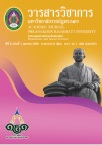การใช้กลวิธีผังมโนทัศน์ในการสอนการอ่านภาษาญี่ปุ่น : กรณีศึกษา ผู้เรียนภาษาญี่ปุ่นชั้นต้นชาวไทย
Keywords:
กลวิธี, ผังมโนทัศน์, การสอนการอ่านภาษาญี่ปุ่น, Strategy, Concept Mapping, Teaching Reading of JapaneseAbstract
การวิจัยในครั้งนี้ มีวัตถุประสงค์เพื่อศึกษา 1) สำรวจประสิทธิภาพของการใช้กลวิธีผังมโนทัศน์ในการสอนการอ่านภาษาญี่ปุ่นชั้นต้น 2) สำรวจผลสัมฤทธิ์ของผู้เรียนในการใช้กลวิธีผังมโนทัศน์ในการอ่านภาษาญี่ปุ่นชั้นต้น 3) ความพึงพอใจของผู้เรียนที่มีต่อกลวิธีผังมโนทัศน์ในการอ่านภาษาญี่ปุ่นชั้นต้นใช้ระเบียบวิธีวิจัยเชิงปริมาณ การใช้กลวิธีผังมโนทัศน์ในการสอนการอ่านภาษาญี่ปุ่น : กรณีศึกษา ผู้เรียนภาษาญี่ปุ่นชั้นต้นชาวไทย กลุ่มตัวอย่าง ได้แก่ นักศึกษาชั้นปีที่ 2 สาขาวิชาภาษาญี่ปุ่นธุรกิจ มหาวิทยาลัยราชภัฏจันทรเกษม จำนวน 35 คน ใช้ระยะเวลาในการทดลอง 7 สัปดาห์ สัปดาห์ละ 3 คาบ คาบละ 50 นาที เครื่องมือที่ใช้ในการเก็บรวบรวมข้อมูล คือ แผนการสอนการอ่านภาษาญี่ปุ่นโดยใช้กลวิธีผังมโนทัศน์ 5 ชนิด ได้แก่ 1) แผนผังใยแมงมุม 2) แผนภูมิขั้นบันได 3) แผนภาพลำดับการคิดเปรียบเทียบ 4) แผนผังก้างปลา 5) แผนภูมิกง จำนวน 7 แผน แบบทดสอบก่อนเรียนและหลังเรียนแบบปรนัย จำนวน 30 ข้อ และแบบสอบถามสำรวจเจตคติแบบมาตราส่วนประมาณค่า 4 ระดับ มีค่าความเชื่อมั่นเท่ากับ 0.83 สถิติที่ใช้ในการวิเคราะห์ข้อมูล ได้แก่ ค่าร้อยละ ค่า่เฉลี่ย และค่าเบี่ยงเบนมาตรฐาน ผลการศึกษาพบว่า 1. กลวิธีผังมโนทัศน์ทั้ง 5 ชนิด ช่วยเพิ่มประสิทธิภาพการอ่านภาษาญี่ปุ่นชั้นต้นได้ในระดับมาก ทั้งโดยรวมและรายด้านทุกด้าน 2. ผลสัมฤทธิ์การสอบหลังใช้กลวิธีผังมโนทัศน์ มีคะแนนเฉลี่ยรวมร้อยละ 80.76 สูงกว่าการสอบก่อนเรียนร้อยละ 18.19 3. ผู้เรียนรู้สึกเห็นด้วยอย่างยิ่งต่อการนำกลวิธีผังมโนทัศน์มาใช้ในการอ่านภาษาญี่ปุ่นชั้นต้นเฉลี่ยในระดับ 3.53 จากคะแนนเต็ม 4.00 กล่าวโดยสรุปคือกลวิธีผังมโนทัศน์ทำให้การอ่านภาษาญี่ปุ่นมีประสิทธิภาพช่วยให้ผู้เรียนมีผลสัมฤทธิ์ดีขึ้น และมีส่วนร่วมในการเรียนรู้มากขึ้น อย่างไรก็ตาม ผู้สอนจะต้องจ้ดสรรเวลาในการอ่านให้เหมาะสม และควรใช้กลวิธีผังมโนทัศน์ในการทำกิจกรรมสรุปใจความสำคัญ ซึ่งอาจประยุกต์ใช้เป็นกิจกรรมเสริมนอกห้องเรียน (Outside Reading Activities) รวมทั้งสามารถนำไปประยุกต์ใช้ในกิจกรรมการเรียนการสอนทักษะอื่น เช่น การพูด และการเขียนได้ด้วย
This present study has been conducted with the major aim to examine the use of concept mapping strategy in an elementary Japanese reading class of Thai learners. The sampling consists of 35 second year students majoring in Business Japanese at Chandrakasem Rajabhat University. The experimental study of 50 minute classes each week has lasted 7 weeks. The instrument used in this study consisted of 7 lesson plans on elementary Japanese reading equipped with 5 concept mapping strategies as follows 1) spider map, 2) time ladder map, 3) contrast overlay map, 4) fish bone map, and 5) pie chart map. In addition 30-item pre-test and post-test were used to assess learning outcome as well as a 4-scale survey to evaluate learner’s attitude. The instruments have been rated to have 0.83 reliability. Statistics used to analyze the obtained data were percentage, mean and standard deviation. The findings were as follows: 1. The 5 concept mapping strategies used in this study were determined to highly optimize reading efficiency of elementary Japanese reading learners both in each and overall perspective. 2. The post-test result indicated the progress of 80.76 per cent which was in accordance with the hypothesis. 3. According to the survey, the learners appeared to be highly satisfied with the using of concept mapping strategy in this elementary Japanese reading class at the level of 3.53 out of 4.00 which was in accordance with the hypothesis. As can be seen in the findings, the use of concept mapping strategy in the elementary Japanese reading class could optimize better learning achievement as well as motivating learners to contribute more collaboration. However teachers should arrange activities which allow students to spend enough time on reading. Additionally, concept mapping strategy should be used in summarizing the main ideas when it can be assigned as an outside reading activity. Furthermore, concept mapping strategy can be applied into writing and speaking class as well as into efficiently summarizing important knowledge in other classes.
Downloads
How to Cite
Issue
Section
License
"บทความวิชาการในวารสารฉบับนี้ ถือเป็นความรับผิดชอบของผู้เขียนเท่านั้น"
สงวนลิขสิทธิ์ตามพระราชบัญญัติลิขสิทธิ์




